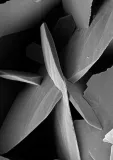Science and Research at the University of Pardubice 2020
(selected scientists)
With its size and specialization, the University of Pardubice ranks among medium-sized public higher education institutions of the university type with a multi-disciplinary structure. It was established gradually from the former college of chemical specialization (1950), transformed into the University (1994), by establishing new faculties with a different field of specialization and integrating a private higher education institution into its structure, which is unique in the Czech Republic. Currently, the University of Pardubice consists of seven faculties, chronologically by date of origin: Faculty of Chemical Technology (1950); Faculty of Economics and Administration (1991), Faculty of Transport Engineering (1993); Faculty of Arts and Philosophy (2001); Faculty of Restoration (Litomyšl) (2005); Faculty of Health Studies (2007) and Faculty of Electrical Engineering and Informatics (2009).
The creative scientific work of each institution is the result of many actors and synergies. From the perspective of long-term publishing activities in internationally respected publication media, the involvement in national and international scientific projects and the establishment of independent scientific schools in cooperation with doctoral students and younger colleagues at the University of Pardubice, we can identify sixteen personalities who represent the main development trends. This publication presents brief profiles, bibliometric profiles and publication characteristics of these scientists.
From the point of view of the development of the institution outlined above, it is understandable that a significant number of personalities are connected with natural and technical sciences. In these disciplines, it is customary to assess long-term activities from the point of view of measurable outputs, which are mostly based on the work published in international journals indexed within the Web of Science. The citation analysis of these published works is then usually considered to be a measure of international importance of the field. At the “Web of Science Categories” level, the University of Pardubice has been outstanding in many fields for a long time. In particular, these are: Chemistry Analytical, Materials Science Ceramics, Physics Condensed Matter, Biochemical Research Methods, Thermodynamics, Electrochemistry, Optics, Polymer Science, Materials Science Textiles, Physics Atomic Molecular Chemical. In the past 20 years, according to the summary citation response, the University of Pardubice has ranked first among universities in the Czech Republic in the fields of Analytical Chemistry, Biochemical Research Methods and Thermodynamics. It ranks second in the field of Optics, and fourth in the field of Physics Condensed Matter.
On the other hand, in the social sciences and the humanities, publications are concentrated more in books and monographs. Here too, however, it is the recognition by the external professional community that is a measure of quality.
By its nature and by definition, science is an international activity. International cooperation is therefore an integral part of quality scientific work and, above all, it is essential in the long term in building viable creative teams. The University maintains intensive international cooperation especially in the field of doctoral study programs. One example among many is the International Cooperative Graduate Program with the National Institute for Materials Science
in Tsukuba, Japan, where our PhD students participate in one-year internships as part of their doctoral studies. This research institution is one of the world’s most successful materials science institutions.
Within the University of Pardubice, the Centre for Materials and Nanotechnologies (CEMNAT; established in 2013) has the largest international and scientific reach. Activities of the Centre, headed by prof. Ing. Miroslav Vlček, CSc., are oriented mainly to the field of materials science (photonics, electronics, renewable energy sources, chemically active surfaces, etc.). With regard to the focus of the Centre, materials are also studied in nanoscale forms (nanoparticles, nanotubes, nanofibers and thin films). The basic and applied research resulting from its activities is represented in the selection below by the scientifically most efficient researcher of CEMNAT
Dr.-Ing. Jan Macák. Since 2016, the Pardubice-based CEMNAT, which has top-class instrumentation at its disposal, has been included in the Czech Republic Roadmap of Large Infrastructures for Research, Experimental Development and Innovation.
prof. RNDr. Zuzana Bílková, Ph.D.
Immunochemistry, Medical Immunology
prof. Ing. Roman Bulánek, Ph.D.
Physical Chemistry
prof. Ing. Filip Bureš, Ph.D.
Organic Chemistry
prof. Ing. Libor Čapek, Ph.D.
Physical Chemistry
prof. Ing. Michal Holčapek, Ph.D.
Analytical Chemistry
prof. Ing. Pavel Jandera, DrSc.
Analytical Chemistry
Dr.- Ing. Jan Macák
Materials Science
prof. Ing. Jiří Málek, DrSc.
Physical Chemistry
prof. Ing. Petr Němec, Ph.D.
Chemistry and Physics of Inorganic Materials
prof. Ing. Aleš Růžička, Ph.D.
General and Inorganic Chemistry
prof. Ing. Tomáš Wágner, DrSc.
Inorganic Chemistry, Solid State Chemistry
doc. Niklas Forsberg, PhD.
Philosophy
doc. Ing. Petr Hájek, Ph.D.
Artificial and Computational Intelligence
doc. Mgr. Jiří Kubeš, PhD.
History
prof. PhDr. Milena Lenderová, CSc.
History
prof. PhDr. Petr Vorel, CSc.
History
